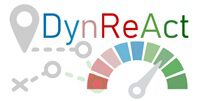Terms used
- Site: the location where the production equipment is located.
- Process step: we assume that the considered production can be split into a series of process steps, each responsible for a particular treatment of the (semi-)products.
- Equipment (sometimes also called Plant in the context of the project): this refers to the main production facilities, such as a cold rolling line. In general, there can be mulitple equipments for each process step. A more general term for equipment is Resource.
- Storage: a buffer where material can be stored, including raw material, semi-products, and final products. Storages are usually connected to specific equipment; each equipment must have at least one input and one output storage. The DynReAct long-term planning module is responsible for keeping storage levels within the prescribed target range.
- Order: An order specifies a set of products to be produced. Usually, customer orders are distinguished from production orders, but the focus of the DynReAct hierarchical planning system is entirely on the latter, so when we talk about orders, it is production orders.
- Material: An order typically consists of one or more materials; they are the basic production units. It is assumed that all relevant characteristics of the materials within an order are constant, implying that no setup activities are required between materials within an order and setup costs within an order are zero.
- Production lot: a production lot is defined for one equipment and assigns a list of orders to be produced at this equipment. In the DynReAct framework, the mid-term planning is reponsible for creating production lots. By definition, a lot should be producable without major setup activities between its constituent orders.
- Production schedule: In the DynReAct language, the production schedule is the actual sequence of orders produced at an equipment. Usually, it is derived from the production lots (i.e., the mid-term planning), but it can be overwritten by the short-term planning.
- Setup costs / transition costs: the transition from one order to the next at a given production line may require setup activities due to different characteristics of the orders, which are captured by a virtual transition cost function.
- Objective function / cost function: the overall objective function, or cost function, captures the goals of the DynReAct mid-term and short-term planning modules, whose aim is to minimize these virtual costs. It includes the transition costs between subsequent orders, but other factors may also contribute to the overall cost function for a sequence of orders at an equipment, such as logistic costs, which are incured if some material needs to be transported from one equipment to another (referring to different equipments at the same process step; for instance, because the material was initially scheduled for equipment A but then switched to equipment B). Additionally, there may also be more global constraints on the production order, not restricted to transitions between subsequent orders, which have to be captured by the cost function, as well. The cost function is heavily use-case dependent and hence must be implemented in a plugin module, which is then loaded by the DynReAct software.
- Material structure: the different products produced at a site can often be grouped according to some rough classification scheme, which we call the material structure. There can be multiple independent material categories, each consisting of a set of material classes. We assume that classes within a given category are comprehensive and exclusive, i.e., every material or order can be assigned to exactly one class per category. Material classes may impose constraints on the equipment that can produce them, so that certain material classes can only be produced at specific equipments at a given process step or may even bypass specific processes. The material structure is the basic subdivision of the production tracked by the order-agnostic long-term planning module.
- Snapshot: a production snapshots captures the current state of the production site, including information about the current location of all materials under production, the status of storages and equipments, and all active production lots. Usually, snapshots can be imported from an MES (see below).
- Plant Performance Model (PPM): a plant performance model captures information about the capability of a plant/equipment to produce specific orders. For instance, if due to quality issues a production line cannot currently produce a specific material class, this will be reported by the performance model. PPMs are typically very specific to inidividual production sites and even process steps, and therefore dedicated PPM software needs to be implemented for each deployment. DynReAct has defined an interface that PPMs can follow in order to allow for their simple integration into the DynReAct platform, and it also comes with a sample PPM that can serve as a template for custom implementations. Whereas the DynReAct software itself usually communicates with automation systems at higher automation levels (level 3 and 4), PPMs may also need to access data from lower levels, closer to the shopfloor, such as level 2 systems.
- Material-Order Allocation / Coil-Order Allocation: before an order can be produced, some raw material must be allocated to it. This is the purpose of the material-order allocation, or in the context of a cold rolling mill, the coil-order allocation, where coil in this specific case refers to a hot-rolled coil as the main raw material for the mill. With respect to the planning hierarchy, the material order allocation must be performed before the mid-term planning is executed.
- ERP, MES and PPS: these acronyms denote different software systems often encountered in producing companies, they stand for “enterprise resource planning”, “manufacturing execution system”, and “production planning system”, respectively. A platform like DynReAct needs to connect to these systems to import and export data.
